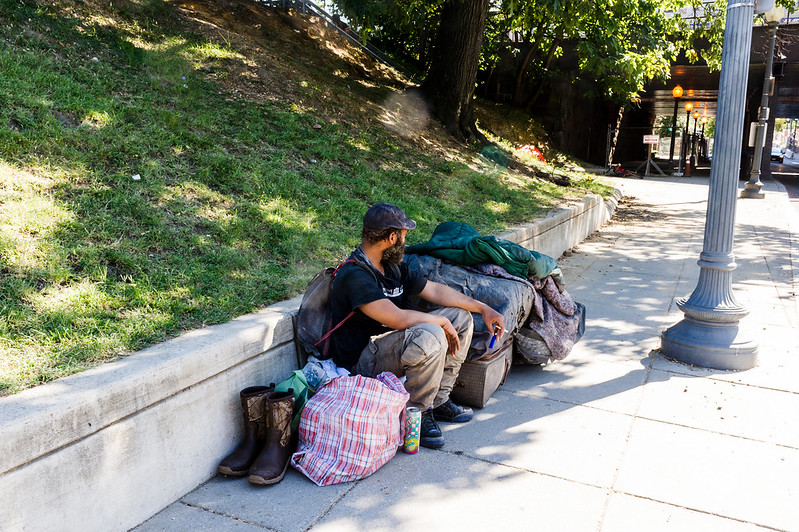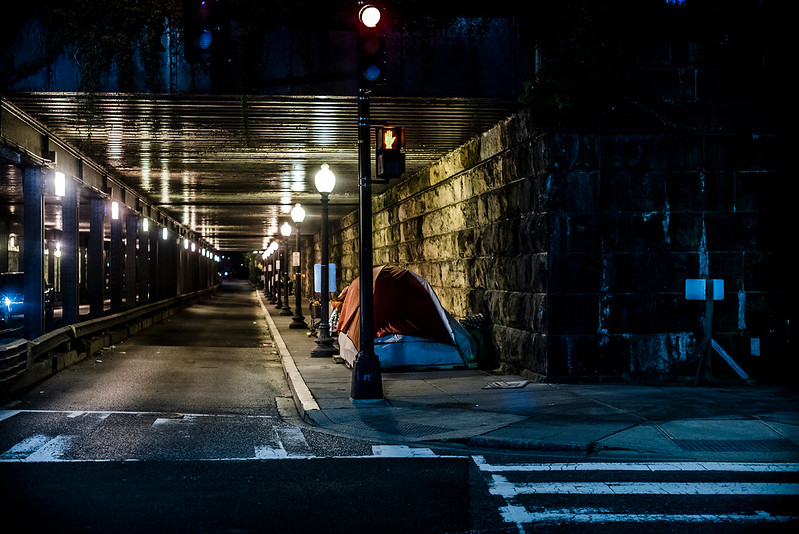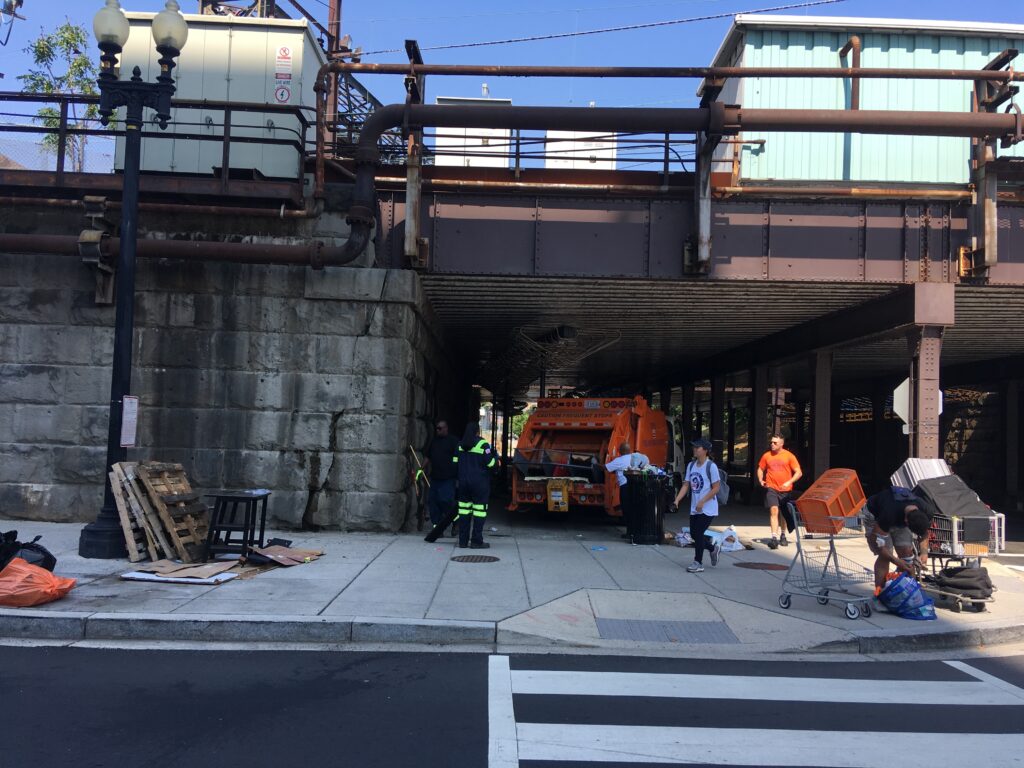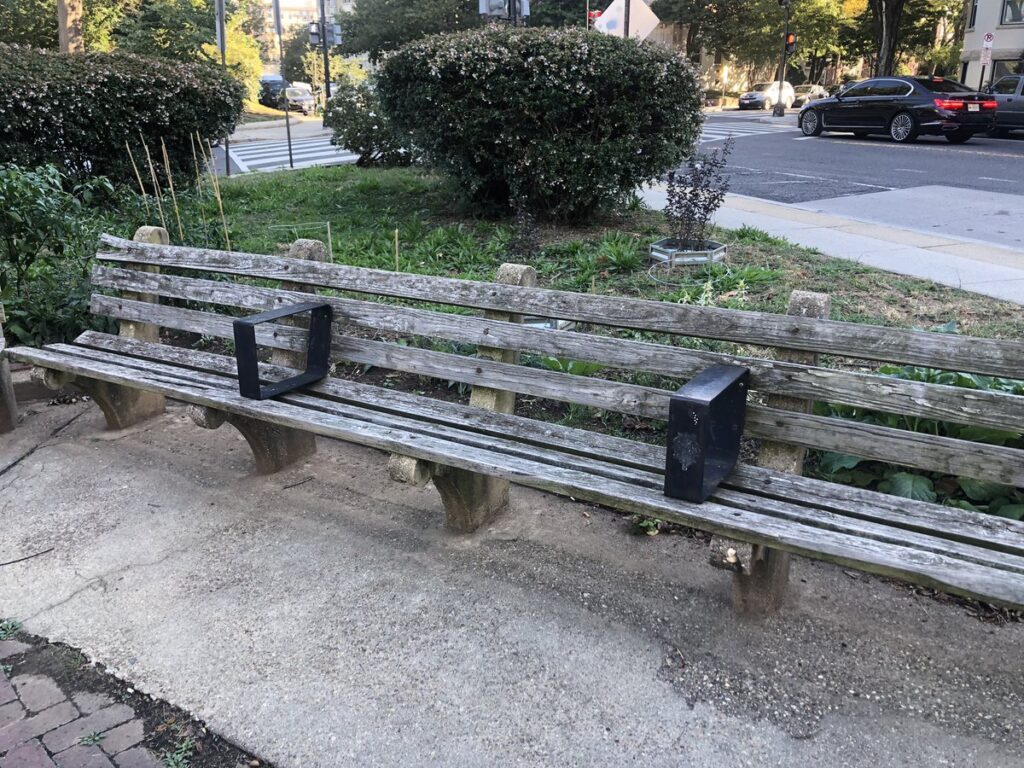The clearing of people and their possessions from the K Street underpass between First and 2nd streets NE will take place on Thursday, Jan. 16 regardless of weather conditions, according to Jessica Smith, a policy analyst for the Office of the Deputy Mayor for Health and Human Services. Despite the forecast for a sunny and breezy day that morning, The National Weather Service predicts a low of 28 degrees that night.
Smith was answering the question of an encampment resident at a Tuesday night meeting she co-led with Department of Human Services Chief of Staff Larry Handerhan, who had marshaled DHS staff members to present and explain resources for those in attendance.
Notices warning that tents will not be allowed on this stretch of K Street NE after the regularly scheduled cleanup of the area were posted on Jan. 2 and Jan. 3. The underpass has been deemed a “pedestrian passageway” that must remain clear at all times.
As Street Sense Media has previously reported, an encampment cleanup is conducted in the NoMa underpasses of M, L, and K streets nearly every two weeks. The number of cleanups conducted throughout the city each year has increased dramatically, from 29 in 2015 to 100 in 2018, according to records the city published online after the NBC Washington News4 investigative team filed a public records request. Three dozen of the 2018 cleanups were performed in NoMa.
In the past, encampment residents have effectively been allowed to return to a site after it has been cleaned. Then another two-week notice would be given saying the site must be cleaned again since the encampment persists in an area that was already deemed a health and safety risk. This will not be the case on Jan. 16.

Concerns boiled over in a hospital-green meeting room at the Department of Behavioral Health’s 35 K Street NE location as city employees, nonprofit service provider staff, people who live in the NoMa underpasses, and other concerned community members discussed the unprecedented permanent eviction, termed an “immediate disposition of property.”
[Read more: An immediate disposition was carried out on K Street in 2018 because the sidewalk was blocked by tents and belongings]
“You’ll see those white standard disposition signs that we always have up come down, and the orange signs will stay up, which say that at any point, things left on K Street are subject to be disposed of,” Smith said. “That is not the goal and is absolutely something we do not want to do, which is why we’re asking you for your help in not keeping your belongings there.”
Immediate dispositions of property are built into the city’s encampment protocol but have not previously been used to enforce an enduring restriction of public space. The D.C. Code prohibits the use of any “temporary abode” such as a trailer or tent but the Bowser administration has consistently said it will not criminalize homelessness and does not enforce charges or fines related to this law.
“We are concerned about safety”
The K Street sidewalks are more narrow than those in the M Street and L Street underpasses and do not provide enough space for both pedestrians and large tents, according to Smith. She said this is dangerous to encampment residents and passersby, describing having seen pedestrians walking in the street to get around tents and having seen tent inhabitants almost stumbling into the street while exiting a tent that is close to the curb.
“I believe that you’ve seen that,” said Shane Sullivan, a community outreach specialist for the nonprofit HIPS. “But the solution that you’re offering is going to produce even more of that. Your solution is to permanently displace people and thus push them even further underground.”

Sullivan called the habitual encampment cleanups without a permanent solution “violence” and said the upcoming permanent clearing was worse.
“I appreciate those comments and I recognize that we have system that we’re continuing to work on,” Smith said. She strived to keep the discussion focused on the implementation of the new policy and plans for moving before it takes effect.
The idea of a “pedestrian safe-passage zone” was first mentioned publicly in a letter published on the NoMa Business Improvement District’s website on Aug. 21. The Washington City Paper subsequently reported that Jasper proposed the idea to Ward 6 Councilmember Charles Allen, The Department of Human Services, and the deputy mayor’s office in a May 6 email where she also claimed to have already made the suggestion to Mayor Muriel Bower’s office.
According to Smith, the policy decision was driven by the observation of the site by the deputy mayor’s outreach team over the past year and particularly over the past several months.
“My team has been out on K Street talking with many folks about how to negotiate having space to be able to pass safely through if you are a pedestrian, if you need more room, if you are in a wheelchair, if you have a stroller — being able to have our tents on K Street and also have K street as a means of pedestrian access,” Smith said. “I’ve come out several times and talked with folks about ‘Can we condense tents?’ ‘Can we move tents over? ‘How can we do a little bit of a Tetris situation where we’re able to navigate through K Street while tents are still there?’”
Michael Harris, an encampment resident from K Street who uses a wheelchair, said it is hard to work with others to move tents when there is no city policy guiding their use.
“The city says you gotta have three feet or four feet of space for a wheelchair to get by … but how close can I get to another tent who’s already there?” Harris said. “Here’s the deal. We’re not really sure. There is no law, there is no rule. But I know one thing. We potentially get our stuff cut up and or stolen [if it is too close].”
Where to go?
A man who gave his name as Brandon described exactly this scenario. He said he lives in a tent on K Street and had already tried to move to one of the other underpasses but was not welcomed. When he moved to M Street, he said his stuff was “cut-up” and stolen. The woman sitting next to him said the clothes she was saving for her daughter were stolen, too. When he moved to L Street, Brandon got in a fight with some of the people already there.
Several encampment residents spoke up to identify the work they put into keeping their area clean, sometimes alleging a lack of similar efforts in the neighboring camp. Then members of the other camp would speak up to defend themselves.
Harris asked if it would be possible for the city or the NoMa BID to help mediate the moves from K Street to surrounding spaces.
Smith reiterated multiple times throughout the meeting that it was not the city’s recommendation that K Street residents just pick up and move to another underpass, understanding that this would be too crowded. She said they hoped to work with people one on one to help them make the move that is right for them.
A formerly homeless man who goes by Scooby suggested hiring encampment residents as “block captains” or “peacekeepers” to help. Handerhan, the DHS chief of staff, asked if there were people in the room who would be interested in that and several raised their hands.
“I hear you say that that should be paid,” Handerhan said. “We’re looking at a lot of peer supports and I think you’re right. I can’t commit to anything right now. But I can commit to looking into it.”
Another man who gave his name as Wayne described himself as being from all three underpass encampments and emphasized that any differences need to be left behind to work together for solutions.
Brandon voiced the worry that if he was not welcome on M or L streets that the only place left to go would be Foggy Bottom, all the way across town. He couldn’t imagine moving all of their belongings — currently stored in carts ready to move — that far without access to a vehicle of some kind.
Help moving
Judy Williams, a supervising social worker and longtime DHS employee said that her outreach team would arrive at the K Street encampment between noon and 12:30 pm on Wednesday to assist people with their moves. Up to two large bags for the temporary storage of clean, nonperishable items would be made available to anyone who desired it. The DHS team will take care of labeling the bags for each individual once they are sealed and a person may reclaim their items at any time by calling the shelter hotline (202-399-7093) to access them at the Adams Place day center. Williams said she would also offer to use her van to help people move their belongings from one place to another.
She reiterated Smith’s plea to remove all belongings from K Street before the cleanup and stressed the importance of sharing all of this information with others. Williams said her team always visits an encampment the night before a cleanup to remind people that it’s coming, or the Friday before a cleanup if the night before would be a holiday.
“It really upsets me when people shut up their stuff and walk away and are not there,” Williams said. “We really give an honest effort. I will stay late. We’ve come out sometimes as late as eight o’clock at night to say ‘The cleanup is tomorrow, and please tell your neighbors.”

According to Alexandra Bradley, the mobile services manager for HIPS, staff, and volunteers from their organization would also be available to help K Street encampment residents move on Wednesday starting at 1 p.m. Bradley added that the nonprofit group The Peace House was gathering volunteers at 6:30 p.m. Wednesday in front of the nearby REI to distribute supplies and help people move. That group has raised more than $5,000 through a GoFundMe page in the name of supplies to help with the move and to help survive cold weather.
“We’re gonna have a lot of volunteers all gathering … to be able to help you guys. So don’t fret so much about the stuff you got,” said Ami Angell, founder of The h3 Project. Her organization planned to support the 6:30 p.m. effort the next day. “We’re all in this together. We all want you guys to have a safe place.”
Pathways to Housing D.C. has also had outreach workers in the area for a long time. Street Outreach Director Jay Forth said they were making a special effort to remain available ahead of and during the Jan. 16 institutions of the pedestrian passageway policy. “[Our outreach staff] want to make sure that everyone has plans leading up to the 16th to make sure that all of your important vital documents are safeguarded and set aside,” Forth said. “We can actually help with preserving those for you and anything else that you might need.
Scooby proposed a moratorium on discarding people’s items as they move to avoid the loss of any vital documents and other important items. Smith said that saving and storing such things is already part of the city’s standard practice, but Scooby said their policy only applied to what city workers can see and identify. He noted that anyone who wants to protect an item is going to hide it, giving the example of a birth certificate wrapped up in a sleeping bag.
Outreach workers from the Office of the Deputy Mayor for Health and Human Services were present Wednesday distributing flyers highlighting the new pedestrian passageway notices.
“Normally when you’re evicted out of a house you’re evicted to the street. We’re being evicted from the street,” Harris said. “Where are we going to go? We need somewhere to go.”
Shelter is available and is a work in progress
“Our DHS commercial is that we have shelter beds,” Williams said. She used the opportunity to highlight a brand new shelter option available as part of the extra shelter capacity that is created at rec centers in the evenings during winter. These seasonal beds open the first night a hypothermia alert is called and remain open every night through March 31.
For the first time, DHS is providing shelter for couples. She said it was a direct result of hearing from people in the encampments who said they did not want to go into shelter because they did not want to be separated from their significant other. This option is only available at the Malcolm X Opportunity Center in Southeast D.C.
“It is far, but the hotline van will pick you up and take you there on a cold night,” Williams said. “You can’t sleep in the same bed but you can sleep under the same roof and survive the night to go out and work together on ending homelessness.”

Handerhan said DHS agrees there should be more co-ed space and the department is looking into making that available year-round.
In addition not wanting to part with a partner or pet, encampment residents often cite cleanliness, bed bugs, lack of privacy, and lack of safety as reasons not to enter a shelter. When concerns were raised at the meeting, he offered to take formal complaints on the spot, saying every formal complaint is investigated.
“We’re not saying [shelters] run perfectly. We are saying that we would prefer people to go into shelter because we think it’s a safer option,” Handerhan said. “We understand that not everyone agrees with us. And we’re not here to convince you of that. We’re here to make sure that you understand what your options are.”
The shelter hotline van (202-399-7093) is available to pick up men and women to take them to shelters in the evening and drop-in centers during the day, according to Williams. Resources for employment, identification, health insurance, and other needs are available at the day centers.
A flyer with information for all available shelters was provided to attendees.
As Street Sense Media has previously reported, the city is in the middle of overhauling its family shelter and preparing to break ground on the first replacement shelter for individuals.
There’s not enough housing
Smith both highlighted that there were service providers in the room that evening to assist individuals and make sure they have assessed to be considered for housing and stressed the importance of keeping the information the city uses to assess vulnerability and need for housing, up to date.
“We have a limited number of vouchers,” Williams said. “And we have less supply than we have demand.”
The city’s assessment for housing needs, the Service Prioritization Decision Assistance Tool (SPDAT), should be updated annually according to her and Handerhan. Williams asked everyone who had already completed a SPDAT to add their name, as spelled in the system, to a list before leaving so that she could check on their status and eligibility for assistance. Handerhan began to apologize for not being able to provide anyone at the event that could complete SPDATs for those who may need them but Angell of The h3 Project volunteered to do the assessments for anyone interested.
“The caseworker business is great,” Harris said. “That’s long- term … You can get a caseworker today, tomorrow, or next week. Things don’t start happening with that individual for quite some time. We are in an emergency situation we have to move in a matter of hours.

Harris went on to ask about the possibility of the city providing single rooms to people as opposed to entire apartments. Williams noted that the city’s rapid rehousing program can place people in apartments or rooms, depending on the individual.
Wayne, the man who said he had lived in all three underpass encampments, talked about the lack of support he and others he knew had experienced when going through the re-entry process.
“Most of the males in here, y’all homeless because of incarceration, right?” Wayne said.
“Mmhmm,” multiple attendees responded.
“When you were released from the jail system, did you get a housing placement?”
“No.”
“Did you fill out any of that paperwork to get a housing placement while doing your time?”
“No.”
He described being released with only a McDonald’s gift card and his Social Security card and birth certificate but needing more to stand a chance when filling out job applications. “At least get me a phone.”
Wayne suggested a short-term housing program to provide more stability while people navigate the job search and assistance programs. He said you need the kind of stability that’s not possible “if you’re worrying about whether some guy’s going to break into your tent in the middle of the night or if your tent is going to be gone when you come back.”
What else could be done?
Anthony Hall, the director of the Department of Behavioral Health’s new 24/7 Community Response Team (888-793-4357) took the time to outline all of the services that have been reorganized and expanded to now fall under his program. Outreach shifts and staff availability span all hours of the day. Services range from checking in on someone and just having a conversation, to pharmacy access to substance abuse treatment or psychiatric evaluation.
“At any point that you feel like assistance: linkage to a service. If you were previously connected with service provider and you want to get reconnected, If you’re not particularly loving your service provider and you want some assistance, changing agencies. These are all cases where we can assist you,” Hall said. “If you’re not quite ready to take that step but an individual wants to talk, you can definitely refer them to us you can come speak to us.”
Williams said she hoped to form a focus group ([email protected]) out of the engaged people that chose to attend that night and to build off of the brainstorming they had begun.
Scooby proposed a storage solution for people experiencing homelessness, such as something easily recognizable and on wheels that would be mobile and recognizable and property that is not abandoned.

Wayne thinks city officials have a skewed view of how the housed residents in the neighborhood feel about the camps. “They say these people are calling and complaining about us. But they don’t know that half of these residents help us — you see I don’t look like I live in a tent.”
He said his housed neighbors provide nice clothes, food and other supplies. They even open their homes to some people who are struggling. In an interview after the meeting, Wayne said he feels bad for the city workers tasked with organizing and carrying out the eviction and said he wishes the mayor had the courage to deliver the bad news herself.
“You live the life you choose,” Wayne said. “So the mayor’s office is choosing not to help.”
[Read more: Advocates say one percent of the DC budget is more than enough to end chronic homelessness]
As encampment residents continued to plan their individual moves, Harris collaborated with a group of Catholic University students to arrange a candlelight vigil for Ms. Bobbie, who died in her tent on K Street on Dec. 17 at age 67. The gathering will take place Thursday evening near the pedestrian passageway at 7:45 p.m.
Street Sense Media is hosting its second community town hall regarding the NoMa encampments on Thursday, Jan. 23.
Updates
( 7:05 p.m.) An initial version of this article was published at 10:50 a.m. Additional information regarding shelters and housing has been added.
(Jan. 16) Photos and links to past coverage have been added.








